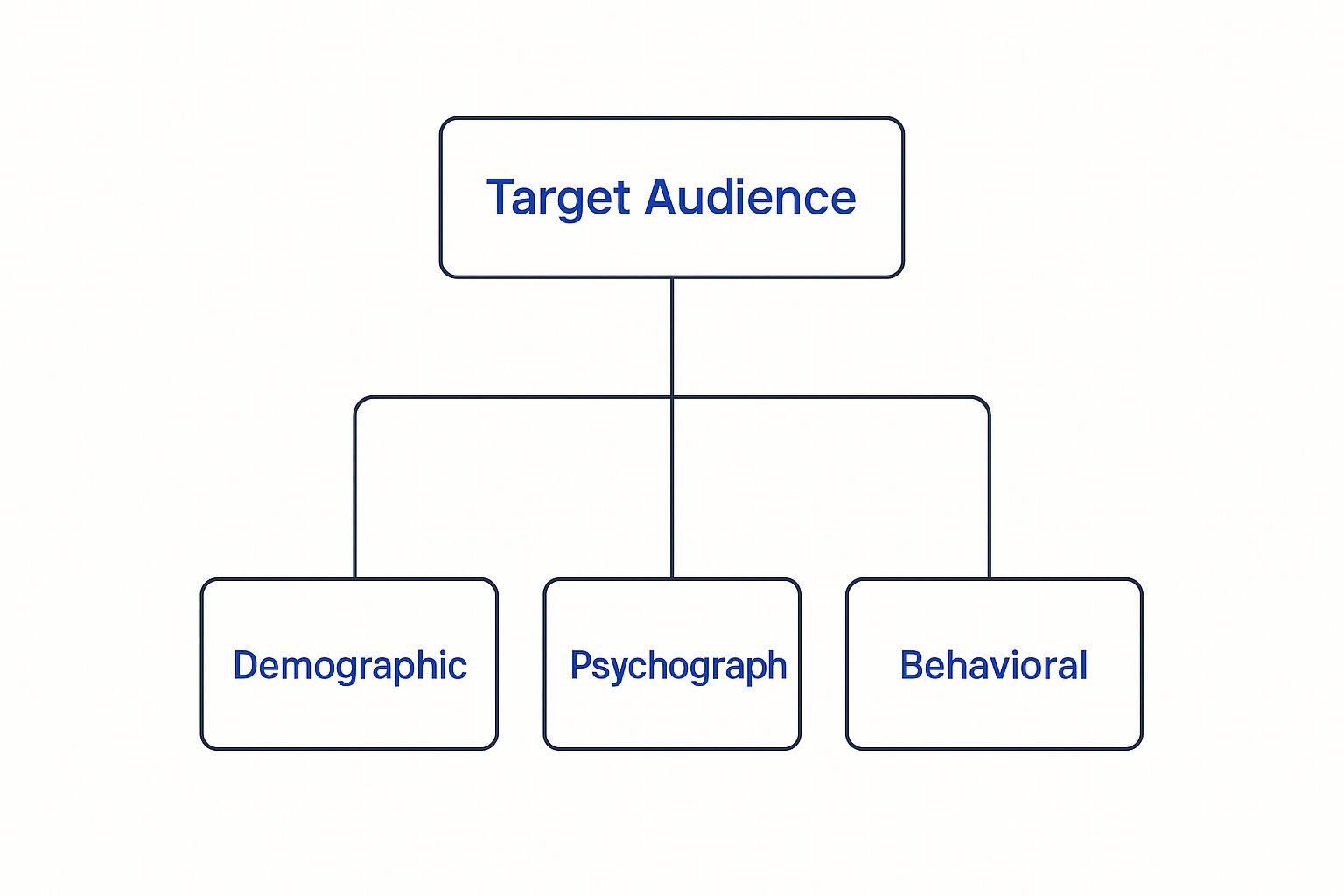Let's be real for a second: your marketing review process is probably a complete mess. I'm talking about the endless email chains, the conflicting feedback dropped in Slack DMs, and the deadlines that fly by faster than you can say, "Wait, who approved this?" It's a universal headache that quietly suffocates creativity and bleeds resources, turning what should be a collaborative high-five into a frustrating slog for everyone.
Why Your Marketing Review Process Is Broken
Does this sound painfully familiar? A designer pours a week of their life into a killer new ad campaign. The first round of feedback is great. Everyone’s excited. Then, just hours before it’s supposed to go live, a senior stakeholder who wasn't even on the original invite swoops in with some wildly subjective feedback that completely torpedoes the entire thing. Back to square one.
This isn't some made-up horror story. For countless marketing teams, this is just… Tuesday. The problem isn't a lack of talent or that people aren't trying hard enough. The real issue is a broken, undefined process that practically rolls out the red carpet for chaos.
The Real-World Pain Points
The signs of a dysfunctional review process are easy to spot once you know what you’re looking for. They usually show up as those "that's just how we do things here" frustrations that teams have grudgingly accepted as normal.
These pain points almost always include:
- Conflicting Feedback: The brand team wants one thing, legal demands something else, and sales has an entirely different opinion. With no clear order of operations, the creative team is stuck in a feedback tug-of-war, trying to make everyone happy and ultimately pleasing no one.
- Endless Revision Cycles: What should be a simple copy tweak somehow turns into a week-long ordeal. This isn't just bad luck; it's a direct result of poor communication and collaboration, trapping projects in a perpetual loop of edits.
- The "Swoop and Poop": You know this one. A stakeholder shows up at the 11th hour to drop feedback that derails everything. This classic bottleneck is a direct result of not clearly defining roles and responsibilities from the get-go.
- No Single Source of Truth: Where does the final feedback live? Is it in an email? A Slack DM? A project management tool comment? A random hallway conversation? When feedback is everywhere, it's impossible to track changes and ensure everything gets addressed.
A broken marketing review process doesn't just slow down projects; it completely demoralizes your team. When your creative people spend more time navigating bureaucracy than actually creating, burnout is right around the corner.
Figuring out which of these problems are plaguing your team is the first real step. This isn't about pointing fingers. It's about getting honest about the specific friction points that are holding you back. Is it a lack of standardized briefs? Unclear stakeholder roles? Relying on a bunch of manual tools that just can't keep up?
Once you pinpoint the root causes, you have everything you need to make a solid case for change. You can finally move from just complaining about the problem to actively designing a review process that’s clear, efficient, and transparent. The goal is to build a system that gets out of the way and lets your team do what they do best: produce amazing work that actually moves the needle.
Before you can dream of speeding up approvals, you need a solid blueprint. A well-defined marketing review process isn't about creating rigid, bureaucratic rules. It's about building a predictable, repeatable system that finally replaces chaos with clarity.
This foundation is built on three pillars: crystal-clear roles, standardized inputs, and realistic timelines. When everyone involved knows their specific part, what’s expected of them, and when it's due, the entire review cycle just flows. The guesswork that grinds projects to a halt simply vanishes.
Define Crystal-Clear Roles
First things first, let's solve the "too many cooks in the kitchen" problem. You need to assign specific roles to every single stakeholder. Ambiguity here is a classic source of friction, leading to a mess of conflicting feedback and infuriating delays. Every person involved in a review should fit into one of three distinct categories.
This simple hierarchy is your best defense against the dreaded "swoop and poop"—when a senior stakeholder drops in late with project-derailing feedback. It clarifies exactly who has the final say versus who is simply offering suggestions.
To eliminate confusion and create real accountability, here’s a breakdown of the essential roles you need in your marketing review workflow.
Key Roles In a Structured Review Process
| Role | Primary Responsibility | Key Action |
|---|---|---|
| Approver | Gives the final sign-off on an asset. Their decision is binding. | Provides the "go" or "no-go" and is accountable for the final outcome. |
| Reviewer | Provides specific, actionable feedback based on their area of expertise (e.g., brand, legal, SEO). | Suggests changes or flags issues but does not have final approval authority. |
| Observer | Stays informed on project progress without providing direct feedback. | Receives updates and views assets for awareness but does not participate in the review cycle. |
Assigning these roles at the very start of a project changes everything. The designer knows they only need that final sign-off from the one designated Approver, even if half a dozen Reviewers have chimed in with their thoughts. For a deeper dive into improving this part of your system, check out our guide on achieving online proofing mastery to transform your content review process.
Standardize Your Inputs
A great review always starts with a great brief. It’s that simple. By standardizing your creative briefs and using feedback checklists, you get everyone aligned from day one. When the initial request is clear and comprehensive, the asset you get back is far more likely to hit the mark on the first try, which dramatically cuts down on revision rounds.
This isn't just theory; it's how modern marketing teams operate. For instance, 36% of companies now integrate social media analytics directly into their marketing decisions. Another 28% regularly use mobile-first surveys to capture customer feedback. A standardized brief ensures this kind of vital data is included from the very beginning, not shoehorned in later.
Just look at how structured audience data—the kind of information a great brief is built on—is organized.

This visual shows why breaking down your target audience into clear, distinct components is so critical for guiding creative development effectively.
Key takeaway: A workflow is only as good as the information that flows through it. Standardizing inputs isn't about adding bureaucracy; it's a strategic move to guarantee clarity and alignment before a single pixel is designed or a single word is written.
To make sure your workflow has a built-in self-improvement mechanism, consider borrowing a page from agile development. Strategies for running effective retrospective meetings are perfect here—they are essentially dedicated review sessions for your process itself. This helps you constantly refine your roles, briefs, and timelines based on what's actually working.
Consolidating Feedback to End Revision Cycles

We've all been there. A single project quickly drowns in a sea of conflicting notes from disconnected email threads, messy Slack channels, and contradictory spreadsheet comments. Scattered feedback is the number one killer of project momentum.
This chaos forces your creative team to become detectives, piecing together a puzzle of opinions instead of focusing on their actual work.
The solution? You have to establish a single source of truth for all feedback. This isn't just a nice-to-have; it's a fundamental requirement for an efficient marketing review process. When every comment, suggestion, and approval lives in one central location, you eliminate ambiguity and create a clear path forward.
From Chaos to Context
The most effective way to consolidate feedback is to use tools that allow for contextual comments directly on the asset itself. Think about it. A designer gets a note that just says, "Make the logo bigger." Bigger where? On which part of the page? It's a recipe for another useless revision.
Contextual tools like BugSmash solve this by letting stakeholders pin comments directly to the specific element they're discussing.
This simple shift provides immediate clarity. Instead of vague instructions, you get precise, actionable feedback that is almost impossible to misinterpret. It’s also brilliant for flushing out conflicts between departments early on.
When the brand team's feedback is pinned right next to the legal team's conflicting note on the same web page element, the conflict becomes visible and undeniable. It forces a necessary conversation and a clear decision from the designated approver, rather than leaving the designer to guess.
Establishing a Clear Decision Hierarchy
Even with the best centralized tools, you're going to get contradictory notes. The brand manager wants punchier copy, while the legal advisor needs to soften the claim. Who gets the final say? This is where your pre-defined roles and decision-making hierarchy become absolutely critical.
To truly end revision cycles, it's crucial to fix any broken content approval process that might be slowing things down. Here’s a practical way to manage conflicting feedback:
- Acknowledge Both Points: The project manager should acknowledge both pieces of feedback right there in the central tool, tagging both stakeholders so everyone sees it.
- Elevate to the Approver: If the reviewers can't resolve the conflict themselves, the designated approver steps in to make the final call. Their decision is then documented directly on the asset for all to see.
- Create an Audit Trail: This process of documenting decisions creates a clear audit trail. It shows why a certain path was chosen, which is invaluable for future projects and team accountability.
By moving away from scattered feedback and establishing a central hub with a clear decision-making protocol, you’re doing more than just getting organized. You empower your team to turn a flood of opinions into a clear, actionable to-do list.
Understanding how to give great design feedback is a skill that, when combined with the right process, transforms endless revision cycles from weeks of frustration into a few days of focused, productive work.
Choosing the Right Tools for Modern Review

Let's be honest: manual review processes just can't keep up anymore. Relying on endless email chains and scattered feedback is a recipe for missed deadlines and frustrated teams. The right technology can completely transform your marketing review process, turning it from a slow, painful chore into an automated system that actually works.
We're not just talking about another project management app. This is about adopting tools built specifically for the chaos of review and approval. Modern platforms are designed to centralize every piece of communication and create a clear, permanent audit trail. That means no more digging through old Slack threads to find that one crucial comment someone made three weeks ago.
What to Look for in a Review Platform
When you're looking at different software, it’s easy to get distracted by flashy features. Instead, zero in on what will solve your biggest headaches. Will this tool finally get rid of the administrative busywork that’s bogging your team down?
A truly great tool should deliver on a few key things:
- Contextual, on-asset feedback: This is a total game-changer. The ability to drop a pin and leave a comment directly on a webpage, a specific video timestamp, or a PDF eliminates all the guesswork. Feedback becomes instantly clear and actionable.
- Solid version control: You absolutely need a system that clearly labels the latest version and lets you compare it to previous drafts. This simple feature prevents the all-too-common mistake of someone reviewing outdated work.
- Automated reminders and notifications: A smart platform will automatically nudge stakeholders when their review is due. This saves your project managers from having to constantly chase people down, freeing them up for more important work.
As you explore different platforms, you'll come across a range of auditing and feedback tools. Options like BugSmash or specialized services such as auditraven's solutions are designed from the ground up to handle this exact kind of workflow.
The Emerging Role of AI in Reviews
Artificial intelligence is quickly becoming a powerful ally in the marketing review process. AI and machine learning are already helping global marketing teams make sense of massive amounts of data and gain deeper customer insights. From the very start, AI-powered algorithms can help fine-tune ad targeting and personalize content, which means the work going into the review cycle is stronger from the get-go.
AI isn't here to replace human reviewers. It's here to supercharge them. It handles the tedious, repetitive tasks so your team can focus on the high-level strategic and creative decisions that actually drive results.
For example, an AI can scan feedback for overall sentiment, automatically flag potential compliance issues or brand guideline violations, and even suggest alternative copy that might perform better. It adds a layer of intelligent automation that makes the entire process smarter, not just faster.
Ultimately, the goal is to make smart technology choices that fit how your team actually works, whether you're a scrappy startup or a large enterprise. By picking the right tools, you can finally kill the friction and delays that have been holding your marketing team back.
Connecting Customer Reviews to Your Workflow

So, you’ve built a bulletproof internal review process. That's fantastic, but it's only half the battle. The true measure of your marketing's success isn’t getting sign-off from your stakeholders—it's winning in the court of public opinion. Customer reviews are where your polished campaigns meet the real world, and this feedback is far too valuable to ignore.
Your marketing review process has to extend beyond your internal team. It needs to actively monitor and engage with what real customers are saying. This means closing the loop—using raw, unfiltered feedback to guide your next campaign, fine-tune your messaging, and prove your marketing's tangible impact.
Turning Public Opinion into Actionable Data
It’s easy to silo customer reviews into a "reputation management" bucket, but that’s a huge mistake. Reviews are one of the most powerful forms of post-launch feedback you can get. Integrating them into your workflow means creating a system to not just see them, but to use them strategically.
The power of social proof is undeniable. Modern research shows that 95% of consumers read online reviews before making a purchase. In fact, a staggering 86% of shoppers will actively avoid businesses with bad feedback. This data highlights that managing your online presence isn't optional; it's a core marketing function.
So, how do you actually harness this power? You need a structured way to listen.
- Monitor Key Platforms: Keep a close eye on reviews from crucial sites like Google, G2, Capterra, or any industry-specific portals. Use tools to pull all these mentions into one place so nothing slips through the cracks.
- Categorize the Feedback: Don't just read comments; tag them. Is the feedback about the product itself, customer service, or the marketing message? Categorizing helps you spot recurring themes and trends.
- Route to the Right Team: A complaint about a software bug should go straight to the product team. But a comment about misleading ad copy? That's a critical data point for the marketing team's next review cycle.
A single negative review about your "easy setup" promise is more than just a complaint; it's a direct signal that your marketing message might be misaligned with the actual customer experience. This is invaluable data for your next creative brief.
Responding and Encouraging Feedback
How you respond to reviews is a form of marketing in itself. A thoughtful, timely reply to negative feedback can turn a detractor into a loyal advocate. At the same time, having a proactive strategy to encourage positive reviews can give your credibility a massive boost.
Consider this: products with five or more reviews have a 270% higher chance of being purchased. This proves that the sheer volume of reviews is just as important as their overall rating. You can learn about proven methods to collect customer feedback to start building this social proof systematically.
Ultimately, this isn't about chasing vanity metrics. It's about building a living archive of customer sentiment that informs every single part of your marketing review process, ensuring your work resonates long after it gets the green light.
Even with the best-laid plans, rolling out a new marketing review process is bound to hit a few bumps. Questions will pop up. Roadblocks will appear. Honestly, just knowing what to expect is half the battle.
Here’s a look at some of the most common sticking points I’ve seen teams run into, along with some battle-tested advice to get you through them.
How Do We Get Other Departments on Board?
Getting buy-in from other teams isn't about forcing rules on them. It's about showing them what’s in it for them. You have to frame the new process as a solution to their specific headaches.
For your legal team, don’t just talk about a "new system." Talk about improved compliance tracking and the rock-solid audit trail it creates for every single decision. For the brand team, focus on how it guarantees consistency and gives them a central hub for all approved creative.
And for sales? That's the easiest pitch of all: a faster path to getting the campaign materials they need to hit their numbers.
A great way to kick things off is with a small pilot project. Find a receptive group, run a project through the new process, and document the time saved. Once you have a real success story with hard numbers, it’s much easier to win over the skeptics.
What Is the Biggest Mistake to Avoid?
The single biggest mistake I see is over-engineering the process right out of the gate. It’s so tempting to build a fortress—a rigid, complex system that tries to account for every possible exception and edge case. The problem? That kind of system is almost always too clunky for anyone to actually use.
Instead, start simple. Build a framework that comfortably handles 80% of your projects. Define the core stages, the essential roles, and the key tools. Launch it, let your team use it for a few weeks, and then gather real-world feedback to iterate.
A great marketing review process evolves with your team; it isn't set in stone from day one. Simplicity encourages adoption, while complexity encourages people to find workarounds.
Is This Really Necessary for a Small Team?
Absolutely. In fact, small teams often feel the benefits the most. When everyone is already wearing multiple hats, a defined process brings much-needed efficiency and stops critical tasks from falling through the cracks. It’s less about bureaucracy and more about creating good habits.
Think of it as building a solid foundation. A clear process prevents that "organized chaos" so common in small businesses from becoming a permanent, unmanageable problem. It allows your team to operate smoothly now and scale without breaking later.
How Should We Handle Urgent Requests?
Urgent, last-minute requests are a fact of life. But they don't have to blow up your entire workflow. The trick is to handle them by building an "expedited" lane within your established process, not by abandoning it altogether.
This express track should have a few clear, simple rules:
- A specific way to submit something as an emergency.
- A smaller, pre-defined group of essential approvers.
- A much shorter turnaround time, like a 4-hour SLA.
To stop this lane from becoming the default, you have to be firm about what truly counts as an emergency. This gives you a controlled, predictable way to handle genuine crises without letting everything descend into chaos.
Ready to eliminate the chaos of scattered feedback and endless revision cycles? BugSmash provides a central hub for contextual feedback on websites, videos, PDFs, and more, creating a single source of truth for your entire team. Stop chasing approvals and start shipping great work faster. Try BugSmash for free today and see the difference.




